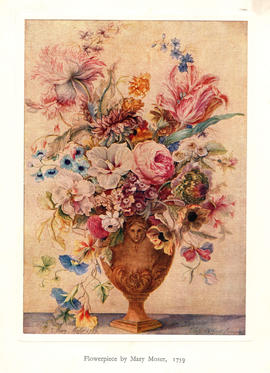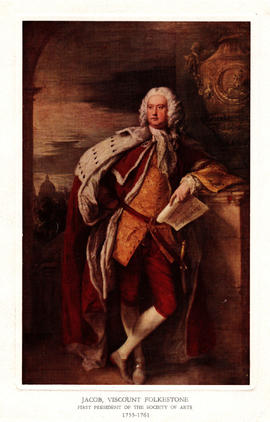Illustration taken from 'Sketches Towards a Hortus Botanicus Americanus...of New and Valuable Plants of the West Indies and North and South America' by W J Titford MD Corresponding member of the Society of Arts, 1812. The Society encouraged the development of the Botanic Garden at St Vincent, where Captain William Bligh left some tropical fruits, including breadfruit for which he was awarded the Society gold medal in 1794.
Taken from a rare mezzotint from the Society's collection. At 20 years of age Lawrie received a bounty of 30 guineas in 1776 from the Society for 'disclosing his method of printing mezzotint in colour'. Lawrie copied the bird form one brought back by Captain Cook in the previous year at the conclusion of his second great voyage of discovery.
Mary Moser made this prize winning drawing when she was only 15. She subsequently became a founding member of the Royal Academy of Arts
Tim Clark was a pupil of the Government School of Design. Illustration from M Digby Wyatt, 'The Industrial Arts of the Nineteenth Century. A series of illustrations of the choicest specimens produced by every nation at the Great Exhibition, 1851' held in the Society's early library
Awarded the sum of twenty guineas by the Society for his set of working drawings in 1824
Landseer awarded the lesser silver palette for this drawing, done when he was 10 years old
Part of the 1998 RSA collection
Part of a pack of ten, all with slightly different designs. Developed from an original Christmas card design sold by the RSA in 1991
Limited edition of 200 copies
Painted by Anna Zinkeisen. In 1758 the Society of Arts offered prizes for what were known as 'ship's blocks', i.e. scale models of ships, in order to 'ascertain by experiments the principles on which a good vessel is founded'. Water resistance and resistance to rolling were two of the main qualities it was desired to test. It was not until 1761 that sufficient models had been submitted for the prizes but that year six entries, 4 32-gun frigates and 2 74-gun ships, were tried at Peerless Pool, near Old Street, in the City of London. 26,500 copies sold.
William Shipley is shown selling winter fuel to the poor at summer prices in a street called the Drapery, in the centre of the town, where he had lodgings and a studio for his professional work as an artist and drawing master from 1747 until 1753. He is being assisted in his calculations by some of the richer Northampton residents who had, after some years' canvass, agreed to subscribe to his fund. The success of his scheme to defeat the Northampton fuel profiteers made Shipley persevere with his plan to raise a national fund for rewarding useful inventions and artistic excellence and in 1753 he came to London with the express purpose of founding a Society of Arts. 28,200 copies sold.
In 1872 the Society offered prizes for improvements in the design of London cabs. Many of the leading cab proprietors and builders of the day put forward their vehicles. These were submitted to extensive testing, including a journey in procession from Kensington to the City and back, by a special committee of the Society, which suggested detailed practical improvements to six of them. Eventually four of the improved cabs were awarded prizes of £30 each. The picture shows the scene in the grounds of Malborough House on 1st November 1872, when the Prince of Wales, President of the Society, inspected the winning cabs. The Journal reports that His Royal Highness 'expressed himself pleased with the vehicles' and 'gave an order for one for use at Sandringham'. The Prince is depicted in the left foreground with members of the Society's Council and on the extreme right is seen the Princess of Wales with her children. 49,500 copies sold.
The Society signed the building agreement with Robert and James Adam on 21st March 1772, and the foundation stone of the House was laid (at its west end) exactly a week later. The work was finished 'most justly and faithfully' to the specifications in April 1774 and the Society took occupation during the following June. The building with pilatered facade which close the view at the end of John Street still survives virtually unchanged. Adelphi Terrace (on the extreme right of the picture) was demolished in 1936. In the group appearing in the left foreground Robert Adam is displaying his design for the front elevation of the House to Members of the Society, whilst his brother James, also carrying plans, points toward the site. 56,700 copies sold.
The back of the House as originally completed faced on to the backs of other nearby, now non-existent, buildings and was hardly visible to the general public. The widening of the Strand in the 1920's brought it into a prominence never contemplated by the architects, Robert and James Adam, and revealed its untidy and ugly appearance. Sir George Sutton, then a Vice-President of the Society, undertook to pay the whole cost of re-designing and decorating it. The work was completed in 1927. It was carried out by Aston Webb, whose pilasters carrying a pediment were based on the design of the existing, original John Adam Street facade. The surmounting figure on the skyline was designed by Walter Gilbert. The reliefs in between the pilasters, symbolizing Arts, Manufactures and Commerce, were modelled by E J Bradford. Used for 1980 Christmas Card
Painted by Anna Zinkeisen. In 1758 the Society of Arts offered prizes for what were known as 'ship's blocks', i.e. scale models of ships, in order to 'ascertain by experiments the principles on which a good vessel is founded'. Water resistance and resistance to rolling were two of the main qualities it was desired to test. It was not until 1761 that sufficient models had been submitted for the prizes but that year six entries, 4 32-gun frigates and 2 74-gun ships, were tried at Peerless Pool, near Old Street, in the City of London. 26,500 copies sold.
The volume of prints from which this image is taken has been in the possession of the Society since it was first published. The Society is listed among the subscribers to the work, which would have been of particular relevance given its longstanding interest in printing (it regularly gave prizes for good examples of this craft). In a letter dated 13 March 1833, Lear wrote :'I have received from the Society a sheet of transferring lithographic paper, desiring my opinion of its suitableness for that purpose, and had I been at all accustomed to practice transferring, I should have felt very glad to have given it. As however I understand nothing of that part of the art of Lithography I have taken it to Mr Hullmandel.' Charles Hullmandel, the printer of 'Illustrations', received a silver medal from the Society in 1819 'for a lithographic drawing'. Lear was given permission to draw from life the parrots belonging to the Zoological Society of London. 18,000 copies sold.
Shipley was a drawing master and the founder of the Society, Cosway was one of his most brilliant pupils

